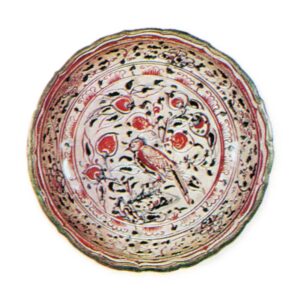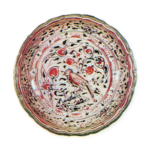
A colorful overglaze painting with red as the main color. A glassy transparent overglaze glaze of red, green, yellow, purple, blue, or other colors is used to add a slightly raised pattern or other coloring to the glaze. Unlike other overglaze paints, however, red is usually not glassy or opaque, and the layer of paint is thin. Generally, a simple and bold design using red as the main tone with one or two other colors added is called akae, while a complex and gorgeous design using a variety of paints is called nishiki. Red is made of ferric oxide (red shell), green is mainly copper oxide with chromium oxide, and yellow is made of iron oxide, lead tan, and gold. Yellow is obtained by mixing iron oxide with lead tan and white jade, manganese oxide is used for purple, and cobalt oxide for indigo.
Kiyoroku [China] Red painting was first developed in China. Among the ceramics excavated from the Hujilu area in Shundefu, Hebei Province, China, there is a red-painted dish with the year Taihe Yuan written in ink, which is the first year of Jiaotai, or 1201 AD, of the Southern Song Dynasty’s Ningzong in the Golden Era. The peony flowers are painted in red and the leaves in green, and the rim of the dish is coated with yellow glaze, indicating that red painting was already in existence during the Song dynasty. In the Ming dynasty (1368-1644), red painting was gradually developed, and such works as Wanryaku red painting and Tenkei red painting appeared. Nanjing red glaze and Wujing red glaze were produced from the end of the Ming dynasty to the beginning of the Qing dynasty. During the Kangxi period (1662-1722) of the Qing dynasty, a very elegant red color was invented and is generally referred to as Kangxi red, but red was no longer the main tone of the design, and other colors were added to reduce the use of red. By the Yongzheng and Qianlong dynasties (1723-95), other colors became the main tone and were called wucai or brocade.
Korea: There was no red painting in the Goryeo Dynasty, and it was not until the mid-Yi Dynasty that it was finally seen, but very few examples remain today. It is thought that Ming Chinese artisans may have come to Korea to make red-painted wares, and that the practice of red-painting ceased after these artisans left.
Japan: The first red painting in Japan is said to have been done by Kakiemon Kakiemon of Minamikawara in Hizen Province (Saga Prefecture) during the Shoho period (1644-8), and Ming-style red painting appeared in Ko-kutani at about the same time. The Hizen akae process was transmitted to Nisei in Kyoto in less than ten years, and Okuda Iegawa in Kyoto copied and made known kuresu akae during the Kyowa and Bunka periods (1801-18). Gosu-aka-e was imitated by Eiraku Shoji, Wazen, Dohachi, and other potters, mainly in Kyoto, and moved to Owari Province (Aichi Prefecture), where it was actively produced at Yingkei in Seto and also at Inuyama. Other red-painted ceramics produced in Japan include those of Komanko, Satsuma Koto, Ando, and Kutani Iidaya. (Studies in Ceramic Crafts, Sometsuke and Akae)








